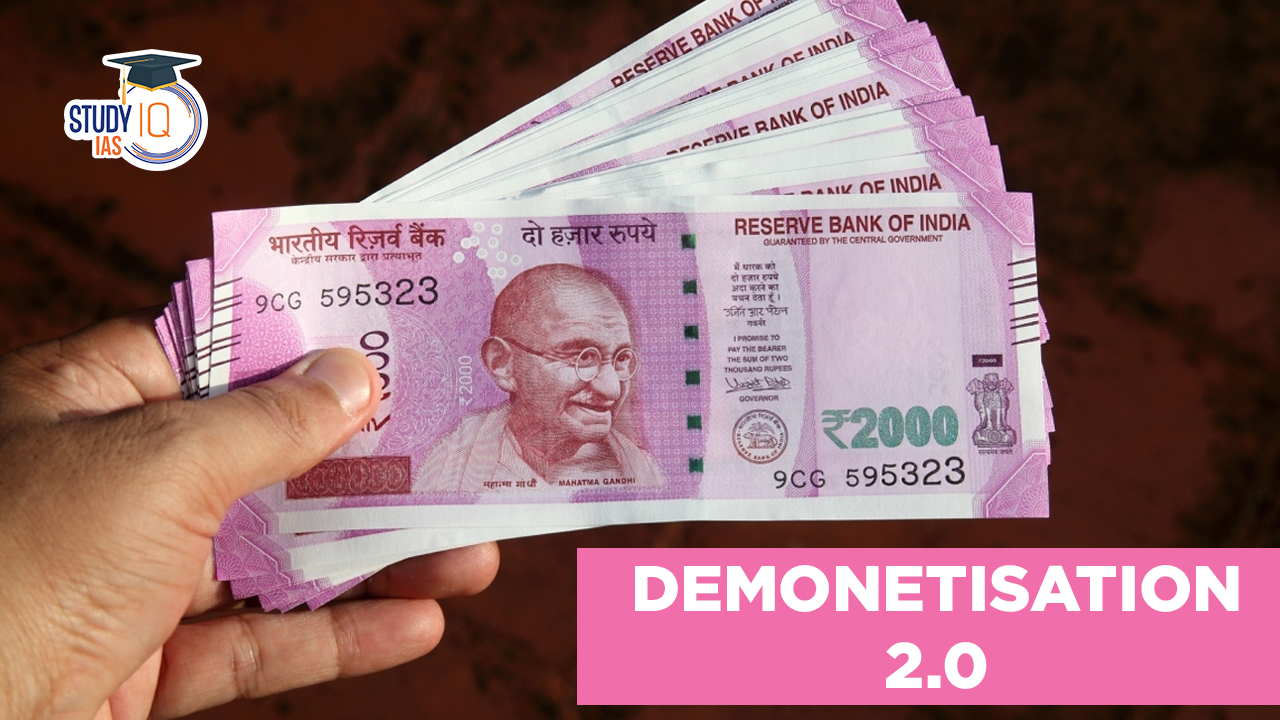Table of Contents
Demonetisation 2.0
The Reserve Bank of India (RBI) has made a momentous decision to stop issuing banknotes with the denomination of 2000 and it is also being said as Demonetisation 2.0. These notes will no longer be printed, although they will still be accepted as legal money. The decision was made since the goal of launching the 2000 banknotes has been achieved and other denominations can now properly meet the economy’s monetary needs.
The Demonetisation 2.0 is an important part of Economy which an important subject in UPSC Syllabus. Students can also go for UPSC Mock Test to get more accuracy in their preparations.
Demonetisation 2.0 Background
After all 500 and 1,000 banknotes in circulation at the moment lost their validity as legal tender, the 2,000 denomination banknote was issued in November 2016 primarily to quickly address the financial needs of the economy. “Once banknotes in various denominations were made sufficiently available in sufficient quantities, the goal of introducing 2,000 banknotes was achieved. Consequently, in 2018–19, the production of 2,000 banknotes was discontinued”.
Demonetisation 2.0 Reason
As a result of the 500 and 1000 banknotes losing their validity as legal tender, 2000 banknotes were introduced in November 2016. This action was taken to address the pressing need for money at the time. However, as the objective of the 2000Rs banknotes had been fulfilled, printing of them was stopped in 2018–19. The RBI also stated that it was uncommon to use 2000 rupee banknotes for transactions.
Demonetisation 2.0 and Declining Circulation
The projected life-span of 4-5 years has now been reached by almost 89% of the 2000-yen banknotes that were printed prior to March 2017. As a result, just 10.8% of all banknotes in circulation as of March 31, 2023, had a value greater than 2000 rupees, down from a peak of 6.73 lakh crore on March 31, 2018, to 3.62 lakh crore. The decision to remove the 2000-yen banknotes was further motivated by the decrease in circulation and limited utilization.
Demonetisation 2.0 and Clean Note Policy
The Demonetisation 2.0 of ₹2000 banknotes aligns with the RBI’s “Clean Note Policy.” This policy aims to maintain the quality of currency in circulation and promote efficiency in the banking system. The RBI had previously undertaken a similar withdrawal of notes from circulation in 2013-2014.
Demonetisation 2.0 and Procedure for Public
The RBI has made instructions available to the general public to help with the withdrawal procedure. Banknotes in the denomination of 2000 can be deposited into accounts or exchanged for banknotes in other denominations at any bank location. Subject to current instructions and statutory requirements, deposits may be made in the customary manner without any limits.
Demonetisation 2.0 and Exchange Process
People can swap their 2000rs banknotes for notes of other denominations to ensure operational ease and minimise disruption to routine banking transactions. Starting on May 23, 2023, this exchange can be performed in any bank, up to a limit of 20,000 at a time. Other banks and the 19 regional offices of the RBI will participate in this interchange process.
Demonetisation 2.0 Timeline and Legal Tender Status
The RBI emphasises that the 2000 banknotes would continue to be legal tender even if the removal procedure has been started. The deadline for people to exchange or deposit their 2000 yen notes in their bank accounts is September 30, 2023. Banks may stop exchanging 2000 banknotes after this date, while they will still be able to be placed into bank accounts.
Demonetisation 2.0 UPSC
Prior to March 2017, the RBI released the majority of the Rs 2000 notes; these notes have now reached the end of their anticipated lifespan of 4-5 years. There is sufficient supply of banknotes in other denominations to meet cash needs, and this denomination is no longer frequently used for transactions. Students can read all the details related to UPSC by visiting the official website of StudyIQ UPSC Online Coaching.


 Nilgiri Biosphere Reserve, Map, Climate,...
Nilgiri Biosphere Reserve, Map, Climate,...
 Repo Rate and Reverse Repo Rate, Impact ...
Repo Rate and Reverse Repo Rate, Impact ...
 Foreign Contribution Regulation Act (FCR...
Foreign Contribution Regulation Act (FCR...





















